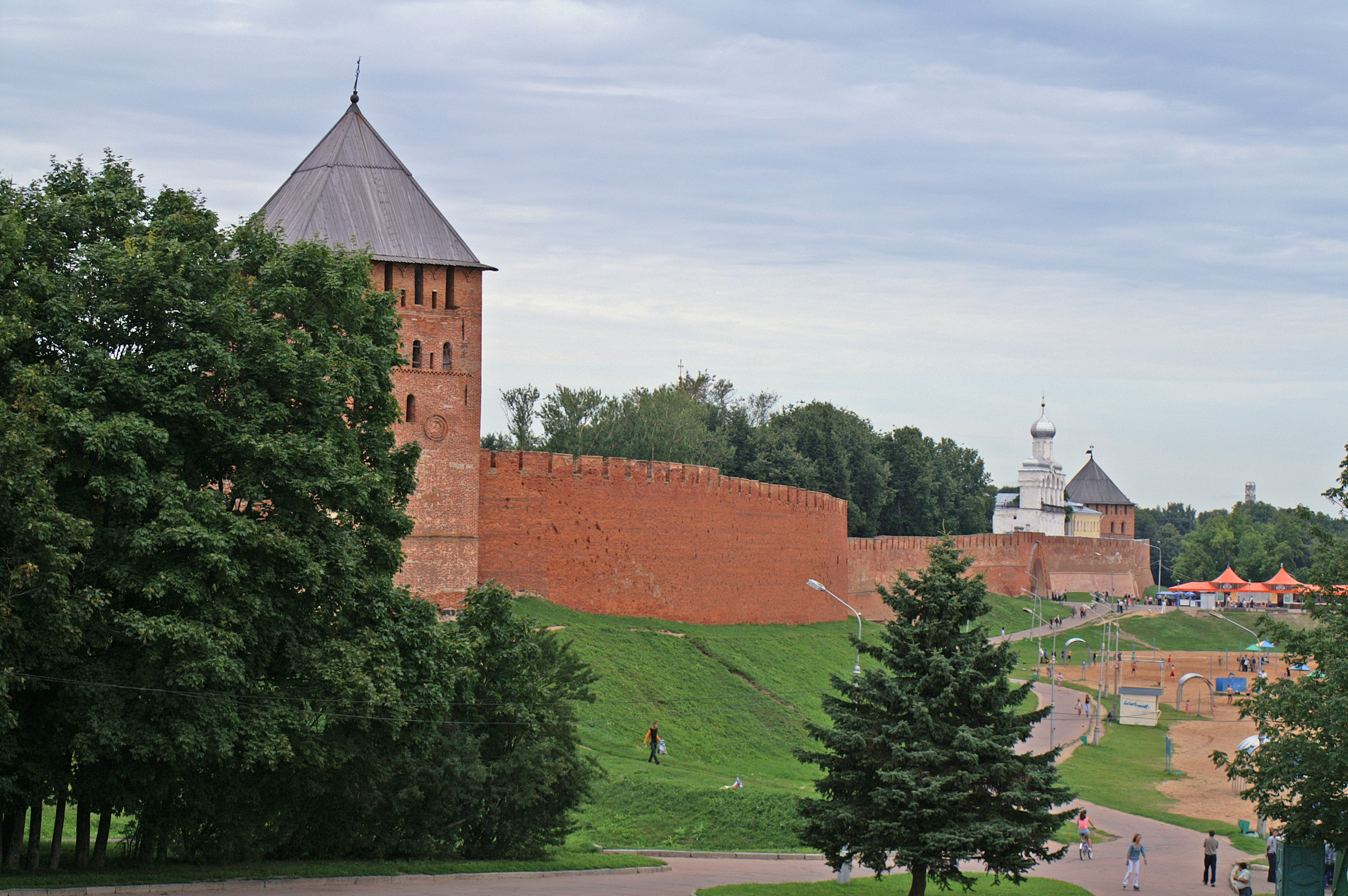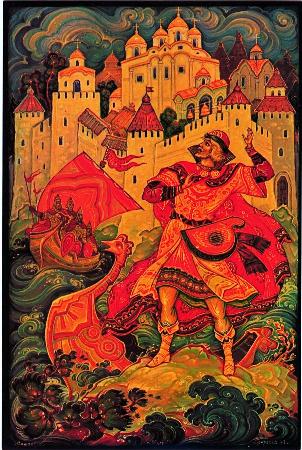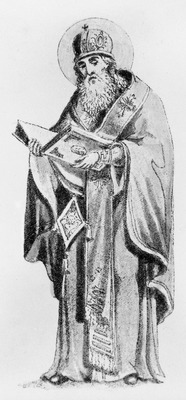|
The Detinets
The Novgorod Detinets (), also known as the Novgorod Kremlin (), is a fortified complex ( detinets) in Veliky Novgorod, Russia. It stands on the left bank of the Volkhov River about two miles north of where it empties out of Lake Ilmen. History The compound was originally the site of a pagan burial ground upon which the first bishop of Novgorod, Ioakim Korsunianin, built the Cathedral of Holy Wisdom upon his arrival in the area in 989 or so. Thus the compound was and remained largely an ecclesiastical site, although many Novgorodian boyars built their houses in the southern part of the Detinets. The first reference of the fortification on the site dates to 1044, with additional construction taking place in 1116. These were probably earthen embankments topped by a wooden palisade, although stone towers and walls were built in 1302. Archbishop Vasily Kalika (1330–1352) rebuilt the stone wall along the eastern side of the Detinets in 1331–1335. The rest was completed in ston ... [...More Info...] [...Related Items...] OR: [Wikipedia] [Google] [Baidu] |
Veliky Novgorod
Veliky Novgorod ( ; , ; ), also known simply as Novgorod (), is the largest city and administrative centre of Novgorod Oblast, Russia. It is one of the oldest cities in Russia, being first mentioned in the 9th century. The city lies along the Volkhov River just downstream from its outflow from Lake Ilmen and is situated on the M10 federal highway connecting Moscow and Saint Petersburg. UNESCO recognized Novgorod as a World Heritage Site in 1992. The city has a population of At its peak during the 14th century, the city was the capital of the Novgorod Republic and was one of Europe's largest cities. The "Великий" part was added to the city's name in 1999. Climate Veliky Novgorod has a humid continental climate (Köppen ''Dfb''). The city has warm summers with temperatures reaching over 30 °C (86 °F) and relatively cold winters with frequent snowfall. The lowest air temperature ever recorded is -45 °C (-49 °F). The warmest month is July with a d ... [...More Info...] [...Related Items...] OR: [Wikipedia] [Google] [Baidu] |
Archbishop Of Novgorod
The Diocese of Novgorod () is one of the oldest offices in the Russian Orthodox Church. The medieval archbishops of Novgorod were among the most important figures in medieval Russian history and culture and their successors (as bishops, archbishops, or metropolitans) have continued to play significant roles in Russian history up to the present day. They patronized a significant number of churches in and around the city, (several of which can still be seen today), and their artistic and architectural embellishments influenced later Russian art and architecture; they also patronized chronicle-writing, a crucial source on medieval Russian history. The Republican period The office of bishop of Novgorod was created around the time of the Christianization of Rus' (988), although the chronicles give conflicting dates for its establishment ranging anywhere from 989 to 992. The first bishop, Joachim of Korsun (ca. 989-1030), built the first (wooden) Cathedral of Holy Wisdom (also cal ... [...More Info...] [...Related Items...] OR: [Wikipedia] [Google] [Baidu] |
Historic Monuments Of Novgorod And Surroundings
The Historic Monuments of Novgorod and Surroundings is a composite World Heritage Site which includes a number of medieval monuments in and around Veliky Novgorod, Russia. The site was inscribed in 1992. History Novgorod between the 9th and the 15th centuries was one of the most significant cities of medieval Rus. It lay on the trade route from the Varangians to the Greeks and was the center of the Novgorod Republic, which included the major part of what is currently northwestern Russia. From the 12th century, it was an example of a medieval republic, in which decisions were taken by veche – a meeting of the city population – and the prince was elected. (The only other Russian city with a similar organization was Pskov.) Novgorod was one of few areas of Rus not affected by the Mongol invasions, and therefore, in particular, active ecclesiastical construction was continuing in Novgorod in the 14th century, while it was stale in the rest of Rus. Novgorod was as well the seat of ... [...More Info...] [...Related Items...] OR: [Wikipedia] [Google] [Baidu] |
German-Soviet War
The Eastern Front, also known as the Great Patriotic War (term), Great Patriotic War in the Soviet Union and its successor states, and the German–Soviet War in modern Germany and Ukraine, was a Theater (warfare), theatre of World War II fought between the European Axis powers and Allies of World War II, Allies, including the Soviet Union (USSR) and Polish Armed Forces in the East, Poland. It encompassed Central Europe, Eastern Europe, Northern Europe, Northeast Europe (Baltic states, Baltics), and Southeast Europe (Balkans), and lasted from 22 June 1941 to 9 May 1945. Of the estimated World War II casualties, 70–85 million deaths attributed to World War II, around 30 million occurred on the Eastern Front, including 9 million children. The Eastern Front was decisive in determining the outcome in the European theatre of World War II, European theatre of operations in World War II, eventually serving as the main reason for the defeat of Nazi Germany and the Axis ... [...More Info...] [...Related Items...] OR: [Wikipedia] [Google] [Baidu] |
Sadko
Sadko () is a principal character in Russian '' byliny'' (oral epic poems). He is an adventurer, merchant, and '' gusli'' musician from Novgorod. The story of Sadko is best known outside Russia in the opera '' Sadko'' by Nikolai Rimsky-Korsakov. Textual notes "Sadko" is a version of the tale translated by Arthur Ransome in ''Old Peter's Russian tales'' (1916). Kate Blakey's translation of a variant, "Sadko, the Rich Merchant Guest", appeared in the ''Slavonic Review'' (1924). A bylina version collected by P. N. Rybnikov has been translated by James Bailey. Synopsis Sadko of Novgorod played the '' gusli'' on the shores of a lake and river. The Sea Tsar enjoyed his music, and offered to help him. Sadko was instructed to make a bet with the local merchants about catching a gold-finned fish in the lake; when he caught it (as provided by the Sea Tsar), the merchants had to pay the wager, making Sadko a rich merchant. Sadko traded on the seas with his new wealth, but did n ... [...More Info...] [...Related Items...] OR: [Wikipedia] [Google] [Baidu] |
Millennium Of Russia
The Millennium of Russia () is a bronze monument in the Novgorod Kremlin. It was erected in 1862 to celebrate the millennium of Rurik's arrival to Novgorod, an event traditionally taken as a starting point of the history of Russian statehood. History A competition to design the monument was held in 1859. An architect Viktor Hartmann and an artist Mikhail Mikeshin were declared the winners. Mikeshin's design called for a grandiose, 15-metre-high ''globus cruciger'' on a bell-shaped pedestal. It was to be encircled with several tiers of sculptures representing Russian monarchs, clerics, generals, and artists active during various periods of Russian history. Mikeshin himself was not a sculptor, therefore the 129 individual statues for the monument were made by the leading Russian sculptors of the day, including his friend and the promising new sculptor, Alexander Opekushin. Rather unexpectedly for such an official project, the tsars and commanders were represented side ... [...More Info...] [...Related Items...] OR: [Wikipedia] [Google] [Baidu] |
Gennady (Archbishop Of Novgorod)
Gennadius (Gennady, ; died 4 December 1505) was Archbishop of Novgorod the Great and Pskov from 1484 to 1504. He was most instrumental in fighting the Heresy of the Judaizers and is famous for compiling the first complete codex of the Bible in Slavic in 1499, known as the Gennady Bible. Gennady is a saint of the Russian Orthodox Church. His feast day is 4 December OS/17 December in the Gregorian Calendar. Biography Gennady was from the Gonzov boyar clan of Moscow and was, prior to his archiepiscopate, hegumen of the Chudov Monastery in the Moscow Kremlin. His immediate predecessor in Novgorod, Sergei, served less than a year. Sergei was recalled and confined to the Chudov Monastery apparently due to mental illness. Gennady was named Archbishop of Novgorod in Moscow and placed in office on 12 December 1484, the first Novgorodian prelate not chosen by lots since 1359. He arrived in Novgorod in January 1485 with the task (as had been Sergei's) of bringing the newly conquere ... [...More Info...] [...Related Items...] OR: [Wikipedia] [Google] [Baidu] |
Ivan III Of Russia
Ivan III Vasilyevich (; 22 January 1440 – 27 October 1505), also known as Ivan the Great, was Grand Prince of Moscow and Sovereign of all Russia, all Russia from 1462 until his death in 1505. Ivan served as the co-ruler and regent for his blind father Vasily II before he officially ascended the throne. He multiplied the territory of his state through conquest, purchase, inheritance and the seizure of lands from his dynastic relatives, and laid the foundations of the centralized Russian state. He also renovated the Kremlin, Moscow Kremlin and introduced a new Sudebnik of 1497, legal code. Ivan is credited with ending the dominance of the Tatars over Russia; his Great Stand on the Ugra River, victory over the Great Horde in 1480 formally restored its independence. Ivan began using the title tsar, and used the title tentatively until the House of Habsburg, Habsburgs recognized it. While officially using "tsar" in his correspondence with other monarchs, he was satisfied with the ... [...More Info...] [...Related Items...] OR: [Wikipedia] [Google] [Baidu] |
Grand Duchy Of Moscow
The Grand Principality of Moscow, or Muscovy, known as the Principality of Moscow until 1389, was a late medieval Russian monarchy. Its capital was the city of Moscow. Originally established as a minor principality in the 13th century, the grand principality was transformed into a centralized Russian state in the late 15th century. Moscow became a separate principality when Daniel of Moscow, Daniel (), the youngest son of Alexander Nevsky, received the city and surrounding area as an appanage. By the end of the 13th century, Moscow had become one of the leading principalities within the Vladimir-Suzdal, Vladimir grand principality, alongside Principality of Tver, Tver. A struggle between the princes of Moscow and Tver began after Mikhail of Tver became Grand Prince of Vladimir, grand prince in 1304. Yury of Moscow, Yury () contested the title and was later made grand prince in 1318 by the Khan (title), khan of the Golden Horde, who held suzerainty over the princes. However, Yu ... [...More Info...] [...Related Items...] OR: [Wikipedia] [Google] [Baidu] |
Brick Gothic
Brick Gothic (, , ) is a specific style of Gothic architecture common in Baltic region, Northeast and Central Europe especially in the regions in and around the Baltic Sea, which do not have resources of standing rock (though Glacial erratic, glacial boulders are sometimes available). The buildings are essentially built using bricks. Buildings classified as Brick Gothic (using a strict definition of the architectural style based on the geographic location) are found in Belgium (and the very north of France), Netherlands, Germany, Poland, Lithuania, Latvia, Estonia, Kaliningrad oblast, Kaliningrad (former East Prussia), Switzerland, Denmark, Sweden and Finland. As the use of baked red brick arrived in Northwestern and Central Europe in the 12th century, the oldest such buildings are classified as the Brick Romanesque. In the 16th century, Brick Gothic was superseded by Brick Renaissance architecture. Brick Gothic is marked by lack of figurative architectural sculpture, widespr ... [...More Info...] [...Related Items...] OR: [Wikipedia] [Google] [Baidu] |
Gothic Architecture
Gothic architecture is an architectural style that was prevalent in Europe from the late 12th to the 16th century, during the High Middle Ages, High and Late Middle Ages, surviving into the 17th and 18th centuries in some areas. It evolved from Romanesque architecture and was succeeded by Renaissance architecture. It originated in the Île-de-France and Picardy regions of northern France. The style at the time was sometimes known as ''opus Francigenum'' (); the term ''Gothic'' was first applied contemptuously during the later Renaissance, by those ambitious to revive the Classical architecture, architecture of classical antiquity. The defining design element of Gothic architecture is the Pointed arch (architecture), pointed arch. The use of the pointed arch in turn led to the development of the pointed rib vault and flying buttresses, combined with elaborate tracery and stained glass windows. At the Abbey of Basilica of Saint-Denis, Saint-Denis, near Paris, the choir was rec ... [...More Info...] [...Related Items...] OR: [Wikipedia] [Google] [Baidu] |








